

Squaw Peak 50 is a classic and tough 50-mile race held in the mountains above Provo, UT. During the early miles, the course climbs the slopes of Squaw Mountain (aka Squaw Peak) a prominent peak that rises above Rock Canyon, frequented by day hikers and rock climbers. It received its name back in the 1800s for “Big Elk’s squaw” who died in the canyon following a battle with pioneer settlers.
This year was the 19th running of Squaw Peak 50, one of the longest running ultras in the country. Before this year, I had run it seven times, and my personal best time is 10:56. It is a tough 50-miler because of the climbs, about 11,000 feet (according to Garmin). The most difficult climb starts at mile 39.5 on a rough trail and climbs about 1,400 feet to the high point of the course in just 1.6 miles without the aid of helpful switchbacks.
Over the past several years I had wondered if running a double Squaw Peak 50 would be possible and how tough that might be. I put it on my “bucket list” to try some day. I knew it would be rough, requiring 50-miles of solo running and about 22,000 feet of climbing along the way.

To prepare for this quest, I decided that I would run the entire course solo, mostly at night, on a different weekend than the race. My first solo Squaw Peak 50 course run was in 2013, a week after the official race. I missed the race that year, instead running Bryce Canyon 100. So, not wanting to miss my fill of Squaw Peak, I ran the course the next weekend. Most of the flagging was still up to help, but I knew the course well and really didn’t need it. My solo run went very well and I loved running most of the course at night. I also gained valuable knowledge where safe water stops were. The following year, in 2014, I again couldn’t make the race because of a family event, so instead I ran the course solo a couple nights before the race, putting up some course flagging along the way. Both times I ran the course in about 14:30, taking it fairly easy, but also limited by some slow-going at night.
This year was the right year to try it. I was in great shape, already finishing six 100-milers thus far in 2015. I checked with the race director John Bozung, and his response was, “You bet. You are amazing and maybe a touch crazy, but what else is new!” My strategy was to run the first 50-mile loop solo, self-supported, and to time it so I could start the second 50 about the time the early starters got going, using the aid stations for the second loop.
I believed that the right way to do this would be to run both loops in the same direction. Yes, I could mix things up and run one loop backwards, but that didn’t seem like a double to me. Katcina Mosa 100K runs much of the course backwards and that is the time to experience it.
The weather report looked a little worrisome, with a 70% chance that I would get caught in a thunderstorm along the way, but the temperatures would be great for running the entire time.
Rather than carrying all my food for the first loop, I decided to make two drop bags with food, water, and other items so I could run without a pack, with just two handheld bottles and stuffed pockets. I dropped a bag at mile 22.5 at Hobble Creek Canyon Road, and also one at mile 33.5, Little Valley.
With everything ready, on Friday afternoon at 1:55 p.m. I was off and running. I wanted to keep my pace solid, but not race speed. My goal for the first 50-mile loop was to finish in about 13 hours. Then with a break at my car, I could time the start for the second loop on Saturday morning at about 4 a.m. with the early starters. I knew that my second loop would be slower, probably between 15-16 hours. My hope for the entire 100 miles was to finish in under 30 hours.
I started off carrying two hand-held bottles, one filled with Ensure and the other with water. Around my waist was a wind breaker and in its pocket a prepared garbage bag to wear in the rain. Thankfully the jacket stayed around my waist the entire time and was never needed.
My early miles went well, comfortable, but quite a bit slower than I usually start out. During the first mile, a runner came toward me, asked if I was Davy and ran a little with me, knowing that I was attempted a double Squaw Peak. He gave me good encouragement and then continued on. The afternoon was warm, but thankfully a cloud cover made the initial climb bearable (2,400 feet in 4.7 miles).
I was amazed at how high the grass was. With our record wet month in May, everything was green and lush, greener than I had ever seen up there. I reached the location of the Hope Camp Ground aid station (mile 5.5) in 1:13. My fastest time to that point was 1:01 in 2010. So my pace was solid, but not blazing fast. I had hoped that at some of the aid station points along the way that I might see someone camped, preparing for the next day, but for me all locations but one were empty. I was somewhat alarmed that the first 15 miles of the course wasn’t marked at all except for the bushwhack sections. I hoped that someone would get out and mark it before the morning. But I knew every mile very well and didn’t need it.
My climbing muscles felt great, especially after four tough repeat climbs of Y Mountain six days earlier. After the first grinding climb, at mile 7.1 you have a fun downhill single track through green grassy slopes into Rock Canyon. Then for the next 15.6 miles the course follows a dirt road (027) all the way to Hobble Creek Canyon, making a few bushwhack shortcuts along the way. If you miss the short cuts, you just do some extra miles.
A about mile 9.5 I reached a creek that has runoff from Freedom Peak, high above. I refilled my bottles. I wasn’t going through my fluids very fast because the temperature was getting cooler and I started to wonder if I should have brought some gloves. I reached the Rock Canyon aid station location (mile 10.9) at 1:58 (3:53 p.m.) and continued ahead through the bushwhack shortcut climbs. I worried about stinging nettles on the legs bushing by some thick leaves, but this year it wasn’t too bad.
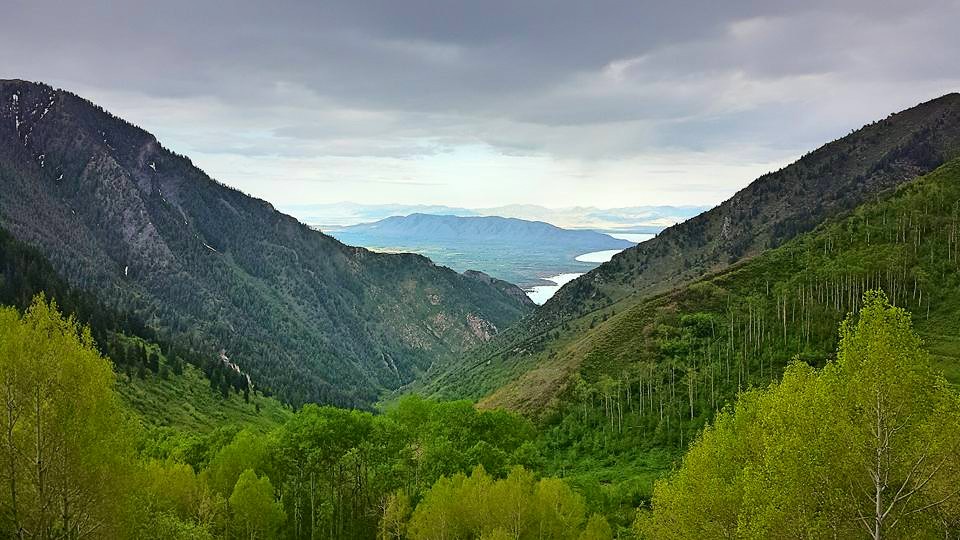
Once I reached the Provo Peak trailhead area at mile 12.2, the sun peaked out and warmed me up nicely. As I ran on the dirt road high above Slate Canyon, I kicked up the speed and was having a wonderful time. I was all alone. Thus far I had only seen a couple of motorcycles. All was nice a quiet.
I reached the Kolob Overlook aid station point (mile 14.8) at 3:41 (5:36 p.m.). My best time to this point was 3:01. My thoughts wandered, thinking that race check-in was happening at that moment. I wondered if people were talking about that “crazy Davy” who was already running, trying to attempt a double.
The next 7.8 miles were all downhill and fast. I waved at an ATV coming up. They gave me curious looks. My legs felt great pushing the downhill. The two short cuts were marked well and fun to run on. I reached the Pole Haven aid station location (mile 20.8) at 4:47 (6:42 p.m.). My PR to that point is 3:58. All was quiet there, with no aid station yet. A couple miles later I reached Hobble Creek Canyon Road (left fork). There I found my bag stashed in the tall grass by a cattle guard. I stopped for six minutes, eating well. I was alarmed to discover that somehow the water bottles weren’t in the bag, and must still be in my car. I would have to drink straight Ensure until I reached a safe stream. I didn’t want to drink unfiltered water out of Hobble Creek.
Next up was pavement for 3.7 miles up the canyon. Usually during the race this can be a hot sunny section, but in the early evening, the canyon was shaded from the sun and the temperature was perfect. I did the road run in only 44 minutes, probably the fastest that I had ever run it, clocking a sub-10-minute mile along the way. I reached the top of the paved road, the aid station location (mile 26.1) at 5:50. I knew that my best time to this point was 4:45, so that thought discouraged me a bit. With no aid station, I didn’t stop and just continued ahead up canyon.
This narrow canyon is private property on either side and the visual pollution of all the no trespassing signs was annoying, with fictitious warnings of video cameras watching my every move. In a couple miles I passed by a scout camp which was full of life. Evening campfire gatherings were starting with boys having lots of fun. The noise died down as I pushed ahead. I reached the Sheep Canyon aid station location (mile 30) at 6:48. I ran that last segment in a personal record time by a minute. I was nearly out of fluid at this point and surprised that the side creek wasn’t flowing, but in another half mile it appeared and I refilled and drank well.
It was now after 9 p.m. and dusk was approaching. It was so pleasant running up the trail and this was the best that I recall feeling at this point in any of my years running the course. I reached Little Valley (mile 33.5) at 7:49 (9:45 a.m.) by the light of my headlamp for the last mile. My best time to this point was 6:40. I found my drop bag hidden in the trees. I had expected someone here to be camping for the aid station, but all was quiet in the valley. I dumped out my drop bag contents onto the road and sat down and rested for ten minutes. I refilled my bottles and pockets, put on a long-sleeve shirt and gloves, a camelback, and grabbed my handheld flashlight (leaving behind a water bottle).
Next up was the toughest stretch, 8 miles of climbing to Windy Pass, all in the dark. I was first alarmed to see that the course was poorly marked. The flags get taken down by riders on horses and at the critical turns, they were gone. My pace was steady and strong as I ran up the Great Western Trail single track climbing toward Bald Knoll. From there the trail rolls around the mountain to the foot of the famed Bozung Hill. The moon kept trying to poke out from behind the clouds and would at time lighten up the valley. I kept a worried look to the skies, wondering if a rain storm would come, but it stayed away. As I climbed up steep Bozung Hill, the wind kicked up at times but I still didn’t need to put on my jacket.
I pushed my way up the seemingly never-ending hill and eventually made my way down the other side to Windy Pass. I arrived at the pass (mile 41.5) at 10:50 (12:45 a.m.). I had covered those last eight miles in less than three hours, which was a solid pace. My fastest time to this point was 9:15. I noticed a tent pitched at the aid station location and flashed my green light on it, but everyone was asleep. Because I still had plenty of water, I decided to skip going to the spring there and continuing on.
Next up was the 5.8-mile, 3,000-foot descent into South Fork Provo Canyon. The trail is rough and rocky, but it can be run pretty fast. I pushed the pace, but the dark limited it and I didn’t want to take a face plant. I reached Big Spring Park aid station (mile 46.5) at 12:29 and refilled my bottle at the bathroom there. There was about 4.4 miles to go and I realized that I would miss a 13 hour finish for 50 miles (really 50.9 miles by my GPS). I tried hard to push the pace on the pavement and arrived back at Vivian Park at 13:07:56 (3:02 a.m.). I ran across what would be the finish line with no cheers and made my way to my car. There were a few early starter runners putting out their drop bags, but they were oblivious toward me. The RD, John wasn’t out yet.
I felt amazingly fantastic. I wasn’t sore and my feet felt fine. I had thought about cleaning my feet, but decided to skip it and just quickly get ready for the next loop. I had no thoughts at all about stopping. I dropped off my camelback, went back to two handheld bottles, and also back to short sleeves. I knew the day would get warm fast. I stuffed my pockets with gels and candy and was ready and off at 3:20 a.m. I ran across the parking look and got curious looks from a few runners, wondering why I was starting before 4:00 a.m. My run clock was still ticking. I also looked forward to a head start on this loop before the early starters, who should be slower runners needing extra time. My son Kevin would be in this group and I left a note on my car letting him know that I was starting loop 2 at 3:20 a.m. I knew that he would be trying to catch up to me.
My pace was much slower this time on the initial climb. I was in no hurry. My only goal was to finish the entire double (100 miles) and do it before dusk. I reached the Hope Camp Ground aid station (mile 5.5, 56.4) in 1:45, 15:07 overall, a pretty slow pace for loop 2. It was getting tough. I became very thirsty on the climb even though the sun wasn’t up yet. I craved for a cold Coke and was delighted that they had some there. I found out that I was the 8th runner who arrived so far, that there was a big group that started at midnight. I know I looked very tired which to the aid station captain made no sense at mile 5.6, so I explained what I was doing. The aid station guy gathered his boy scouts and told him what was going on, that I was on my second loop. It was fun and lifted my spirits.
On the way again, about a mile later I was shocked to see that some of the early starters had already caught up. That made no sense, and I clearly could see that they were not slow runners at all. They must have disregarded the RD’s strong notes that the early start was only for slower runners. The true front-runner who started at 5:00 a.m., 1:40 after me, caught up to me at about mile 8. He was moving fast. I reached Rock Canyon aid station (mile 10.9, 61.8) at 3:24, 16:46. The people there could see that I was pretty thrashed, so again I explained. They were surprised to hear what mile I was on. I stopped for a few minutes to regroup.
Finally at the top of the initial climb, my low point seemed to fade away and I felt better. The run along the road to Kolob Overlook was fun. Friends caught up and it was clear that most of them knew what I was doing. The words of encouragement were much appreciated. Gee, everyone knew my goal, there was no way I could quit now. I also heard that my son Kevin was about ten minutes behind and getting closer. As I approached the next aid station I could see him coming. I arrived at Kolob Overlook aid station (mile 14.8, 65,6) at 4:38, 17:59. I waited there for Kevin and rested up for the long run down the road ahead. We took off together and Kevin was moving well. We were getting passed by the faster runners who started an hour after Kevin. About half of them recognized me.
After a few miles my long-time problem knee started to ache from the pounding at this point and slowed me down. I could only manage 11:30 pace. Kevin went on ahead but he missed the first short-cut section and about a mile or so later he appeared behind me. So again we were able to run together for a while but soon he disappear down the road. I was able to keep a run going nearly the entire downhill. Other runners who caught up were now starting to slow down and walk at times. I arrived again at Pole Haven (mile 20.8, 71.7) at 6:01, 19:23). I sat down for about five minutes. No other runners were sitting down. I know that I looked like a real loser runner, having to sit down after only 20 miles. Little did they know.
I don’t know how many runners had passed me at this point, but they were now mid-pack runners and I could generally keep up with most of them. These runners were on a pace for a 12-hour finish. I would crank up my pace to match theirs but then would have to slow and rest. At the Hobble Creek Canyon Road, I again visited my hidden drop bag, and asked a crew to throw away the stuff I couldn’t take with me. After a bathroom break and a ten-minute stop, I was on my way up the paved road. I refused to walk. Now I was passing runners. I received complements, even from runners who had no idea I was on my second loop! During my first loop I ran the road in 44 minutes, this time in 47 minutes. I was pleased. I arrived at the aid station at the top of the paved road (mile 26.1, 77.0) at 7:20, 20:42.
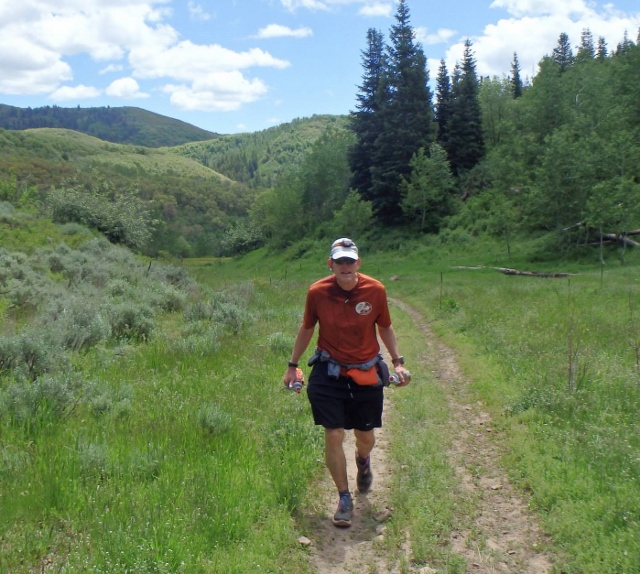
The next couple sections on the climb to Little Valley was a struggle but I kept going. Many kind runners caught up and ran with me for a little while, encouraging me, saying things that were much too kind. The Little Valley cutoff was at 2:30 p.m. I worried what would happen if I missed that. There was no way anyone could stop me for a silly cutoff time. But such a confrontation never took place. I arrived at Little Valley (mile 33.5, 84.4) at 1:18 p.m. (9:58, 23:20). I found my hidden drop bag and looked funny coming into the aid station holding a bag. It was a crowded place as many runners who were ahead of me were taking very long stops there.

Tom Remkes greeted me and made a very big deal about my run and accomplishments. He brought me everything I needed. 84 miles! At this point in a 100-miler, the finish seems so far away. I had no choice but to push on. I joked with Tom that there was only one hill left. I stayed for just five minutes, repassing a bunch of runners.
The runners around we were now running at a pace to finish in 14 hours. I could pretty easily keep pace with them and kept leap frogging several for the next couple miles. I would be told, “you are an animal,” “you are amazing!” I didn’t feel amazing. I again started to struggle and slow down. With only two water bottles, I worried that this long stretch to Windy Pass could take me well over four hours. When I reached the last stream coming down from Bald Knoll, I drank plenty and filled up. Every mile, I needed to stop and rest for a couple minutes. Puzzled runners who didn’t know me would come up, “Are you OK?” They had no idea that I was on mile 87 or so. I looked like an old man who got in over his head trying to run 50 miles. But others who knew me, kept encouraging me, asking me over and over again if I needed anything at all. Wow, they really perked me up.
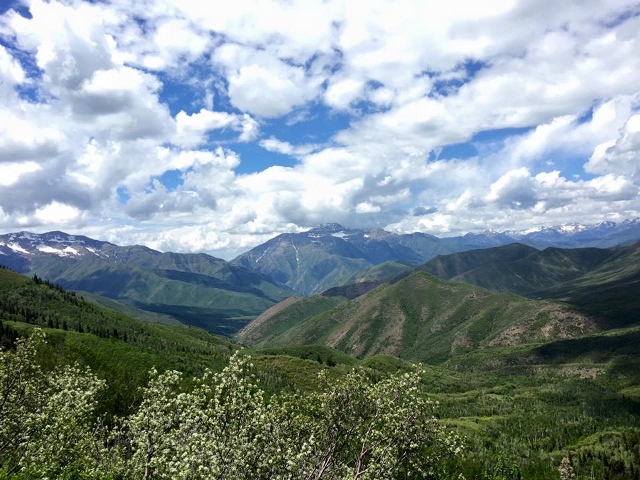
Finally my system jump-started again as I made my way around Bald Knoll and started to set time goals. No, I wasn’t going to take four hours to reach Windy Pass. It was time to really work. When I reached the base of Bozung Hill, I put my head down, very determined, and started to charge up that hill as fast as I could. I used compression breathing and kept the machine pumping. I passed three runners, then another three, then passed a group of five midnight starters, and more ahead. Determined, I wouldn’t let myself stop. I went from the base of hill to the high point of the course in only 45 minutes. The previous night on loop 1 it had taken me 57 minutes. Wow! I felt fantastic with huge climbing strength. All I can determine is that the steep slope was using different muscle groups that wanted to work. I sipped on Heed the entire way and it fueled me well.
I arrived at Windy Pass (mile 41.5, 93.4) at 13:16, 26:38. One guy there knew I was on my second loop and gave me special attention. The others there, including runners had surprised looks on their faces as they heard I was finishing my second trip. Now some runners who I had leap-frogged understood the whole story. I didn’t stay long, I was ready to get this done.
As I started down the steep trail, I ran into my son-in-law, Jon Potter. He had hiked up and was supposed to pace son Kevin on the last miles from Windy Pass. “Where’s Kevin?” He pointed down the trail, “Just a little ahead of you.” Jon needed to go fill his bottle at the aid station. I pushed on ahead, very surprised that I had almost caught back up with Kevin who had probably been miles ahead of me. My quick push up Bozung Hill had caught up a bunch of time. I tried and tried to catch Kevin, but around every turn he was not there. Jon caught up again and then went on ahead to go pace Kevin. It seemed like I was running fast, but it was only 16:00 mile pace.
The problem was my feet. I had not taken the time to stop and clean my feet at all. I later discovered that my shoes had reached end-of-life, probably with more than 600 miles on them. Hot spots were starting to blister. I slowed to a slow painful walk. I had no choice now. I stopped for about 15 minutes to clean and take care of my feet. It was the right thing to do and I should have done it sooner. Back on the trail again, I started to fly. I found sub-10:00 pace again.
Thunder was heard to the west and I kept looking up at the clouds. I didn’t want to run across the big open field in a couple miles with lightning striking around me. But the storm stayed away. I came into Big Spring Park (mile 46.5, 97.4) at 15:17, 28:29. Suzanne Barney was there and handed me a full cold bottle of Coke. Just what I needed! Oh, it tasted so good. I didn’t want to hang around, it was time to get this finished, so with coke in hand, I ran on.
Now, my final goal was to simply finish before the 30-hour mark. The pavement felt hard at nearly 100 miles and I slowed, yet I did manage 12-minute miles and didn’t walk much. With a half mile to go, my family drove up the road cheering, heading up to Big Spring Park to get Jon’s car. I ran on. Finally, after all this time, with about 100 yards to go it started to rain. I had managed to dodge the rain for nearly the entire way. People saw me coming and I saw a bunch of people got up and went to the finish line to cheer me.
I had done it! I paused at the finish line for some pictures and crossed at 29:32:20, and nearly 102 miles on my GPS. It wasn’t overly speedy, but I showed that a double Squaw Peak 50 could be accomplished and I was the first one to do it. One guy later asked me, “if you don’t mind, how old are you?” “56, almost 57.” “Wow.” Yes, I probably looked like death at the finish, but I felt relatively fine. John presented me with TWO finishing medals. Kevin fist-bumped me and I was ready to head home.
Should there be a Squaw Peak 100? Several years ago I ran Buffalo Run 100 solo to test out a potential 100 there. The next year it became an official distance. Hopefully the same thing can happen for a Squaw Peak 100. I had a great experience and know others could too. My 7th 100-mile finish for 2015 is in the books now, and also my 70th career 100-miler. I’ll count this one since it was endorsed by the race director. I came in 1st place and set a course record! My daughter reminded me that I also came in last place.
Recovery for some reason was a little rough for the next couple days, but by Monday evening I had bounced back was started thinking about my next run.



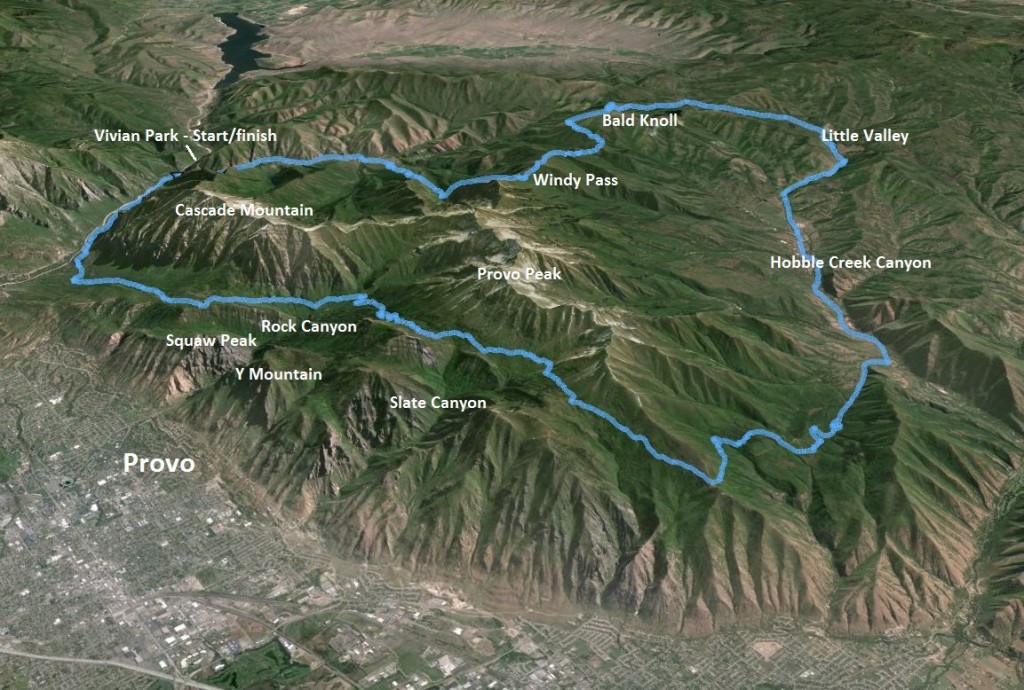
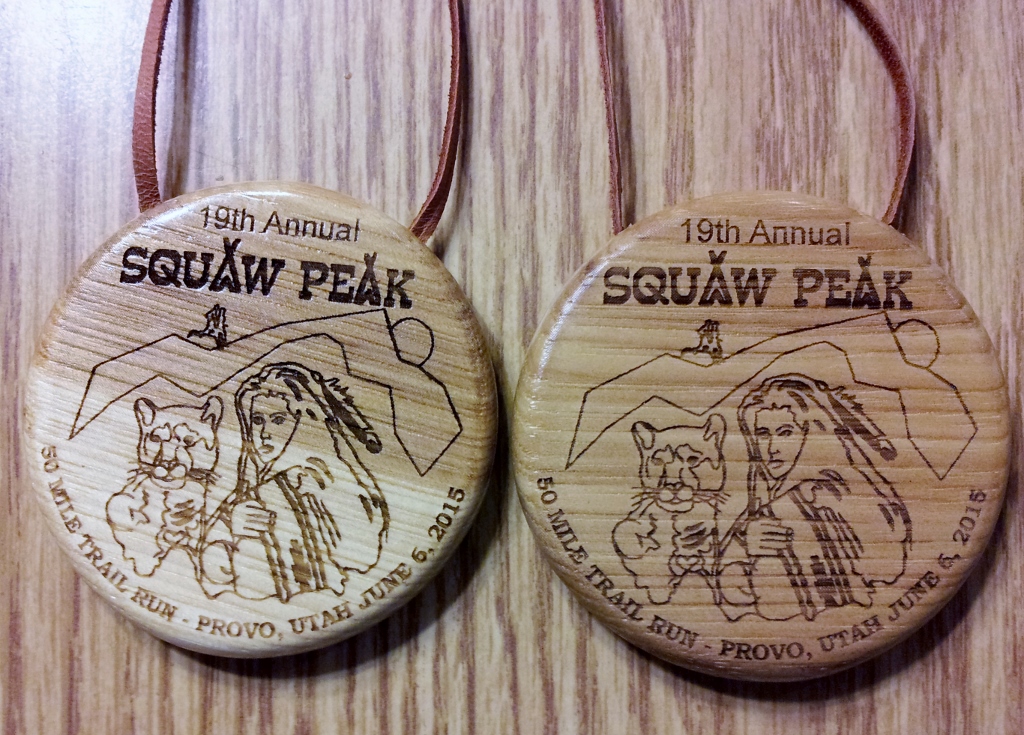
Enjoyable read, Davey. Having run SP 5 or 6 times myself, I was able to visualize much of the course as you were describing it. What a great adventure.
Great write-up Davy. I appreciate the detail that you put into your race reports. Congrats on another 100! I look forward to sharing some time on the trail and running some loops with you next week.
What is compression breathing? I want to learn about this.
Basically deep breathing. To get a deep breath blow out and then inhale deeply. At higher altitude if you do that as you climb you oxygen level increases quickly.